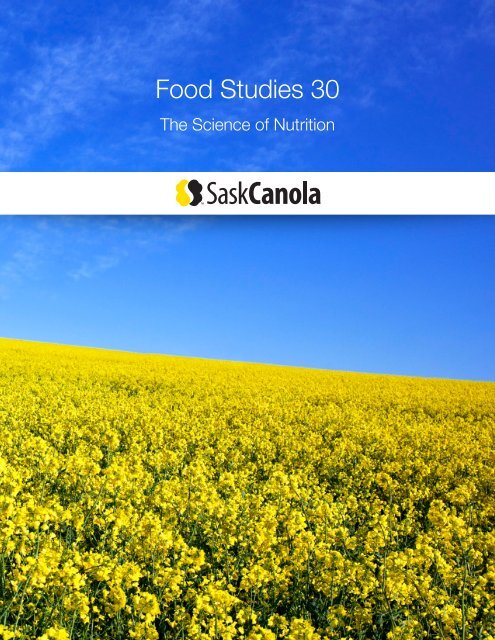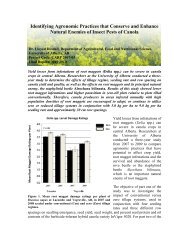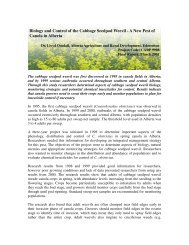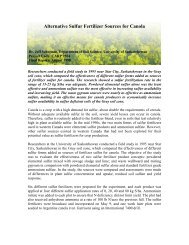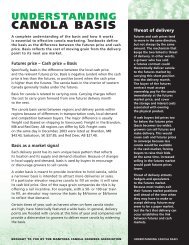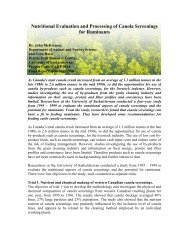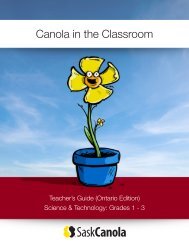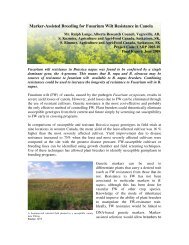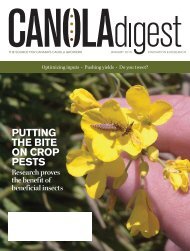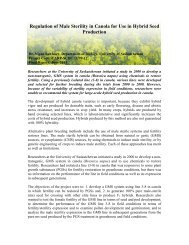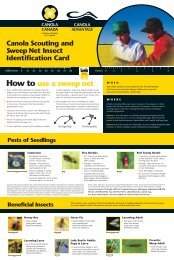Food Studies 30 - SaskCanola
Food Studies 30 - SaskCanola
Food Studies 30 - SaskCanola
- No tags were found...
You also want an ePaper? Increase the reach of your titles
YUMPU automatically turns print PDFs into web optimized ePapers that Google loves.
Foundational & Learning ObjectivesNutrition - The Right BalanceFoundational ObjectiveTo understand the importance of the science of nutrition.Learning ObjectivesTo appreciate how understanding nutrition can benefit your body.Nutrients, Nutrients, NutrientsFoundational ObjectiveTo understand the importance of the science of nutrition.Learning ObjectivesTo recognize that nutrients work in combinations in the body.There’s Healthy Fats In Those Canola Seeds!Foundational ObjectiveTo understand the importance of the science of nutrition.Learning ObjectivesTo understand fats and their role in the diet.
This Teacher’s Guide is designed to provide the teacher with a comprehensive resource that will assiststudents in learning about canola. The information provides a context for both teaching and learning. Thestudent activities give the teacher direction for using the facts about this important crop in the Canadianeconomy. The Guided Inquiry tool should be used to guide your students towards asking these questions ontheir own.Table of ContentsNutrition - The Right BalanceTeacher Notes .............................................2BLM 1 ....................................................3BLM 2 ....................................................4BLM 3 ....................................................5BLM 4 ....................................................6Nutrients, Nutrients, NutrientsTeacher Notes .............................................7BLM 5 ....................................................8BLM 6 ....................................................9BLM 7 ...................................................10There’s Healthy Fats In Those Canola Seeds!Teacher Notes ............................................11BLM 8 ...................................................12BLM 9 ...................................................13BLM 10 ..................................................14BLM 11 ..................................................15Teachers are granted permission to reproduce activities from this document for classroom use only.Reproduction for purposes other than classroom use, in any format, requires permission from <strong>SaskCanola</strong>.1
Nutrition - The Right BalanceLessonThis lesson is designed to educate studentsabout the new daily oil requirement and how toincorporate oil into their daily diet.Foundational ObjectiveTo understand the importance of the scienceof nutrition.Learning ObjectiveTo appreciate how understanding nutrition canbenefit your body.Guided Inquiry1. Does the human body need nutrients tosurvive and work properly?2. How can nutritional knowledge be usedto evaluate daily eating patterns andfood choices?Activity1. Use the table in BLM 3 to discuss a healthy,2000 calorie/day diet.2. Split the class into two groups. One groupwill prepare the soup; one group willprepare the salad.3. All students with taste both the soup andsalad and complete the second half of theirassignment in BLM 4.Assessment1. Assess answers to questions for accuracyand completion.2. Assess comparison sheets for thoughtfulanswers and completion.Materials1. Student copies of BLM 1, BLM 2, BLM 3,BLM 4.2. Ingredients for making soup and salad:baby spinach leaves, dried cranberries,shaved almonds, green onions, light fetacheese, canola oil, balsamic vinegar, poppyseeds, sugar, salt, pepper, onion, whitemushroom shiitake mushrooms, garlic,chicken stock, milk, bay leaves, and parsley.Assignment1. Students read BLM 1.2. Students complete first half of theirassignment in BLM 4.2
The<strong>SaskCanola</strong> Postwww.saskcanola.com CANOLA OIL. GOOD FOR EVERY BODY! Since 1991Nutrition:The Right BalanceBy Ellen Hinz of The <strong>SaskCanola</strong> Post“Observe aplant before andafter wateringand relate thesebenefits to yourbody and brain.”Just as a car runsbest with a full tankof gas, your bodyneeds the rightkind of “nutritionalfuel” for peakperformance. Eatingwell can be verysimple. You do notneed special foodsor supplements. Itis important to fuelyour body with a balance of carbohydrates, proteins, fatsand oils, vitamins, minerals, and water.The body’s essential nutrients are composed of chemicalelements found in food and used by the body to performmany different functions. <strong>Food</strong> provides heat, promotesgrowth, repairs tissue, and regulates body processes.Carbohydrates are a major source of human energy andcan be easily digested. Carbohydrates should make up40-50% of your daily diet.Proteins make up the basic components of all bodycells, are essential for building and repairing tissue,regulating body functions, and providing energy andheat. Proteins should make up 10-15% of your dailydiet on a caloric basis.Fats and oils provide the most concentrated formof energy, maintain body temperature by providinginsulation, cushion organs and bones, and aid in theabsorption of fat soluble vitamins. Fats and oils shouldmake up 25-<strong>30</strong>% of your daily diet on a caloric basis.Vitamins are organic (living) compounds that are essentialto life. Vitamins are important for metabolism, tissuebuilding, and regulating body processes. Vitamins allowthe body to use the energy provided by carbohydrates,fats and oils, and proteins. A well balanced diet usuallysupplies adequate amounts of vitamins.Minerals are inorganic (non living) elements found inall body cells. Minerals regulate body fluids, assist invarious body functions, contribute to growth, and aid inbuilding tissues.Water is found in all body tissues. Water is essential forthe digestion (breakdown) of food, makes up most of theblood plasma, helps body tissues absorb nutrients, andhelps move waste material through the body. The averageperson should try to drink 6 to 8 glasses of water per day.Regular meals and healthy snacks will help fuel your body.It is important to give your body enough of the right fuel inorder to feel good and have the energy you need to be thebest you can be. By following the recommendationsin Canada’s <strong>Food</strong> Guide, you can be assured that youwill meet your daily requirements for vitamins, mineralsand other nutrients, helping you to achieve overall healthand vitality.The Canada <strong>Food</strong> Guide has used a range of evidenceto shape the revised <strong>Food</strong> Guide. Nutrient standards andprevention of chronic disease were key scientific inputs.Canada’s <strong>Food</strong> Guide also outlines a number of servingswe should eat from each of the four food groups andprovides guidance on portion sizes. The recommendednumber of serving sizes is based on age and gender.Remember that it is just the average amount that peopleshould try to eat each day.Aside from the four groups, the revised <strong>Food</strong> Guiderecommends that you include a small amount - <strong>30</strong> to45 mL (2 to 3 Tbsp) - of unsaturated fat each day. Thisincludes oil used for cooking, salad dressings, margarine,and mayonnaise. Use vegetable oils such as canola, olive,and soybean. Choose soft margarines that are low insaturated and trans fats. Limit butter, hard margarine, lard,and shortening.Achieving a balance between activity and nutrition isimportant for overall health. Use Canada’s <strong>Food</strong> Guideto find the right balance and take control of your life andyour future. You will feel better and improve your ability tolive a full and active life.BLM 13
Cranberry Spinach Salad with Poppy Seed DressingIngredients:1 (10 oz) bag of baby spinach leaves1 cup dried cranberries2/3 cup shaved toasted almonds4 green onions1/3 cup crumbled light feta cheese2/3 cup canola oil2 Tbsp balsamic vinegar with raspberryjuice vinegar1 Tbsp poppy seeds2 tsp granulated sugar1/2 tsp salt1/4 tsp pepperDirections:In a large salad bowl, combine spinach, cranberries,almonds, green onions, and feta cheese.In a separate small bowl, combine canola oil,balsamic vinegar, poppy seeds, sugar, salt, andpepper. Mix well. Pour dressing on top of saladingredients and toss lightly. Serve immediately.Yield: 6 servings.Creamy Wild Rice SoupIngredients:2 Tbsp canola oil1 medium onion, finely chopped3 cups white mushrooms, slice thick1 cup shiitake mushrooms1 clove garlic, minced1 1/2 cups chicken stock2 1/2 cups milk1 bay leaf1/2 tsp parsley3 Tbsp all purpose flour1/2 tsp salt1/2 tsp ground pepper1 1/2 - 2 cups cooked wild riceDirections:Heat canola oil in frying pan. Saute onion,mushrooms, and garlic until tender. Removefrom heat.In medium saucepan, mix together chicken stockand milk over medium heat until it comes to aboil. Add mushroom mixture, bay leaf, parsley,flour, salt, pepper, and wild rice to milk mixture.Stir occasionally and simmer for 20 to <strong>30</strong> minutes.Remove bay leaf and serve.Yield: 6-8 servings.4BLM 2
Based on a 2000 Calorie / Day Diet% of calories gramsCarbohydrates 40 - 50 % 200 - 250 gProteins 10 - 15 % 50 - 75 gFats 25 - <strong>30</strong> % 40 - 70 gRecognizing that:Carbohydrates = 4 calories/gramProteins = 4 calories/gramFats = 9 calories/gramBLM 35
Nutrition - The Right BalanceName: _________________________________Read the article & answer the following questions:1. What is the new daily oil requirement and how can we incorporate oil into our daily diet?2. What does food provide to our bodies?3. Name the six important nutrients.Salad & Soup AssessmentTaste test both the salad and the soup, then assess.1. Explain the color and appearance of both food items.2. Explain the taste of each food item.3. Note the texture and density of each food item.4. Do you prefer one food item better than the other? Why?6BLM 4
Nutrients, Nutrients, NutrientsLessonThis lesson focuses on nutrients in our diet. Thediscussion examines the relationship betweencarbohydrates, fats, and proteins that are used toprovide energy for the body.Foundational ObjectiveTo understand the importance of the scienceof nutrition.Learning ObjectiveTo recognize that nutrients work in combinations inthe body.Activity1. Split the class into two groups. One groupwill prepare the vegetables; one group willprepare the smoothies.2. All students with taste both the vegetablesand smoothies and complete the secondhalf of their assignment in BLM 7.Assessment1. Assess answers to questions for accuracyand completion.2. Assess comparison sheets for thoughtfulanswers and completion.Guided Inquiry1. What role do nutrients play in the body?2. What is the relationship amongcarbohydrates, fats, and proteins used toprovide energy for the body?Materials1. Student copies of BLM 5, BLM 6, andBLM 7.2. Ingredients for making roasted vegetablesand smoothies: canola oil, maple syrup, redpepper, green pepper, cauliflower, sweetpotato, acorn squash, parsnips, carrots,garlic, red onion, salt, pepper, dried basil,banana, blueberries, strawberries, greentea, and cranberry juice.Assignment1. Students read BLM 5.2. Students complete first half of theirassignment in BLM 7.7
The<strong>SaskCanola</strong> Postwww.saskcanola.com CANOLA OIL. GOOD FOR EVERY BODY! Since 19918Nutrients, Nutrients,NutrientsBy Ellen Hinz of The <strong>SaskCanola</strong> PostA nutrient is a chemical that an organism needs tolive and grow or a substance used in an organism’smetabolism which must be taken in from its environment.Nutrients are the substances that enrich the body.Nutrients build and repair tissues, give heat and energy,and regulate body processes.Organic nutrients include carbohydrates, fats, proteins,vitamins, and minerals. A nutrient is essential to anorganism if it cannot be synthesized by the organismin sufficient quantities and must be obtained from anexternal source. Nutrients needed in large quantities arecalled macronutrients; nutrients needed in small quantitiesare called micronutrients.Micronutrients and macronutrients from food areabsorbed by the body as it passes through the digestivesystem. Although nutrients can work alone, each dependsupon the others to be the most effective.Let’s talk vitamins and minerals! Vitamins are organicchemicals that a living organism requires in smallquantities for good health. Vitamins and minerals do notprovide energy on their own, but macronutrients dependon vitamins and minerals to regulate the release of energyfrom food.Let’s talk carbohydrates! Carbohydrates provide energyfor the body. Carbohydrates also protect your musclesand help regulate the amount of sugar circulating in yourblood so that all the cells get the energy they need.An average healthy adult needs 200-250 grams ofcarbohydrates per day. Carbohydrates come in twoforms: simple and complex. Both are composed of unitsof sugar. The difference is how many sugar units theycontain, and how they link together. Simple carbohydratesare sugars that give you instant energy and typicallyhave no nutritional value. These include sweets, candy,and soda. Complex carbohydrates release energyslowly and often contain fiber. These “healthier” formsof carbohydrates include bread, pasta, rice, potatoes,cereals, and legumes.Most Canadians do not get enough fiber in their diet.Choosing whole grain options like brown rice or wholewheat pasta, increases fiber intake.Let’s talk protein! Protein is used by the body to buildnew cells, maintain muscle, and regulate cell function.About half of the protein consumed daily is convertedinto enzymes. Enzymes work in the body to regulate thespeed of biological reactions, permit it to digest food,and assemble or divide molecules to make new cellsand chemical substances. To perform these functions,enzymes often need specific vitamins and minerals.Twenty two different amino acids are required to make allthe proteins that the body needs. Nine are essential andare not synthesized by the body so they must be obtainedfrom food. Our bodies can produce the other thirteennon-essential amino acids from fats, carbohydrates, andamino acids.An average healthy adult needs 50-75 grams of proteinper day. Good sources of protein can be found in meat,poultry, fish, eggs, cheese, nuts, legumes, and soy.Let’s talk fats! Fats aid in energy production, cellbuilding, oxygen transport, blood clotting, and theproduction of extremely active hormone-like substancescalled prostaglandins.Fats can be saturated, polyunsaturated, andmonounsaturated. Monounsaturated and saturated fatscan be produced by our bodies. Polyunsaturated fats, oressential fatty acids, cannot be synthesized by the bodyso they must be obtained from our diet.An average healthy adult needs 40-70 grams offat per day, with most fats coming from sources ofpolyunsaturated and monounsaturated fatty acids,such as fish, nuts, and vegetable oils. All vegetableoils and animal fats are a mixture of unsaturated andsaturated fats; it is the amounts of monounsaturated,polyunsaturated, and saturated that determine which arehealthier oils. The more unsaturated, the more healthythe oil. Canola oil and olive oil are good sources ofmonounsaturated fats.The advantage of eating specific nutrient rich foods isthat the body can readily absorb and utilize the contentswithout having to remanufacture or convert refinedingredients. The less work the body has to do to nourishitself, the better!BLM 5
Maple Roasted VegetablesIngredients:1/3 cup canola oil1/3 cup maple syrup1 each red and green peppers, cubed1/2 head cauliflower, cut into florets1 sweet potato, cubed1 acorn squash, peeled and cubed4 parsnips, peeled and cut lengthwise4 carrots, peeled and cut lengthwise1 head of garlic, peeled and separated1 large red onion, cut into eighths1 tsp salt1 tsp pepper1 Tbsp dried basilDirections:Preheat oven to 425 F (220 C).In a large bowl, mix together canola oil, maplesyrup, peppers, cauliflower, sweet potatoes,squash, parsnips, carrots, garlic, red onion, salt,pepper, and basil. Place mixture on a baking panlined with parchment paper.Bake for 40-45 minutes, stirring occasionally untilveggies are tender.Yield: 10 servings.Berry Good For You SmoothieIngredients:1 medium banana1/2 cup blueberries1/2 cup strawberries1/2 cup green tea, cooled1/2 cup cranberry juice4 ice cubes2 tsp canola oilDirections:In a blender, add banana, blueberries, strawberries,green tea, cranberry juice, ice cubes, and canola oil.Blend until combined. Serve immediately.Yield: 2 cups for 2 servings of 1 cup.BLM 69
Nutrients, Nutrients, NutrientsName: _________________________________Read the article & answer the following questions:1. What is a nutrient?2. What is the difference between micronutrients and macronutrients?3. What can we eat to increase our fiber intake?Vegetable & Smoothie AssessmentTaste test both the vegetables and the smoothie, then assess.1. Explain the color and appearance of both food items.2. Explain the taste of each food item.3. Note the texture and density of each food item.4. Do you prefer one food item better than the other? Why?10BLM 7
There’s Healthy Fats In Those Canola Seeds!LessonThis lesson focuses on fat in our diet. Thediscussion centers on the nutritional benefitsof canola oil.Foundational ObjectiveTo understand the importance of the scienceof nutrition.Learning ObjectiveTo understand fats and their role in the diet.Guided Inquiry1. What are fatty acids and why are theyimportant for good health?2. What are some foods that are high in fat?3. What are some of the health risksassociated with too much fat in the diet?Activity1. Use the table of dietary fats to explore thecomposition of dietary fats and review thecanola oil baking substitution chart.2. Split the class into two groups. Each groupwill prepare a brownie recipe; one groupwith butter and one group with canola oil.3. All students will taste each brownieand complete the second half of theirassignment in BLM 11 .Assessment1. Assess answers to questions for accuracyand completion.2. Assess comparison sheets for thoughtfulanswers and completion.Materials1. Student copies of BLM 8, BLM 9, BLM 10,BLM 11.2. Ingredients for making brownies: canolacooking spray, sugar, flour, vanilla extract,baking powder, salt, eggs, semi-sweetchocolate chips, cocoa, canola oil,and butter.Assignment1. Students read BLM 8.2. Students answer the questions in BLM 11.11
The<strong>SaskCanola</strong> Postwww.saskcanola.com CANOLA OIL. GOOD FOR EVERY BODY! Since 1991There’s Healthy Fats InThose Canola Seeds!By Ellen Hinz of The <strong>SaskCanola</strong> PostOne of the reasons canola is popular as an oilseed crop isits nutritional properties. Canola is rapidly gaining acreageon the Canadian prairies because of the strong demandfor its healthy oil.Most oilseeds contain much the same balance of protein,fibre and other types of carbohydrates - mainly from thehull of the seed - and fats. Fats are made up of varioustypes of fatty acids and glycerine. The key differencebetween the various oils you’ll find on the grocery shelf istheir composition of fatty acids.Some fatty acids are essential nutrients, meaning theycan’t be produced from other compounds and need tobe consumed in small amounts. Fats play a vital rolein maintaining healthy skin and hair, insulating bodyorgans against shock, maintaining body temperature,and promoting healthy cell function. Fats also serve asenergy stores for the body, containing about 9 caloriesper gram of fat. Vitamins A, D, E, and K are fat solublevitamins meaning they can only be digested, absorbed,and transported in conjunction with fats.Fats are determined to be healthy or unhealthy based ontheir fatty acid composition. Fats and oils are composedof fatty acids. Fatty acids are chains of carbon moleculeswith hydrogen attached, they vary in length and theamount of saturation which affect how they are named.Saturated FatThe Skinny on FatsFatTrans FattyAcidsMonounsaturatedFatUnsaturatedFatPolyunsaturatedFatThe three main types of fats are: unsaturatedfat, saturated fat, and trans fat. There are twokinds of unsaturated fats: monounsaturated andpolyunsaturated.Unsaturated fats are called good fats becausethey can improve blood cholesterol levels,ease inflammation and stabilize heart rhythms.Unsaturated fats are mostly found in foodsfrom plants, such as vegetable oils, nuts, andseeds. They are liquid at room temperature.Monounsaturated fats are found in vegetable oilssuch as canola, olive and peanut oils, nuts, seeds,and avocados. Polyunsaturated fats are found invegetable oils such as canola, safflower, flaxseed,corn, and hemp seed; fish is also a good source.There are two types of polyunsaturated fats:omega-3 and omega-6 — the number refers tothe position of the first double bond of the carbonchain, which means it’s unsaturated. Omega-3fats are an important type of polyunsaturated fatbecause the body can’t make these, so theseessential fatty acids must come from food. Goodsources of omega-3 fats are found in vegetableoils such as canola, soybean and flaxseed oil, chiaseeds, flax seeds, walnuts, and fish. Omega-3 fattyacids are also known to offer significant healthbenefits: Alpha-linolenic and other omega-3s mayreduce the risk of cardiovascular disease—a heartattack or stroke.Saturated fats are chiefly found in animal sourcessuch as meat fat, milk fat, and butter, as well as,coconut and palm oil. High intake of saturatedfats has been linked to higher blood cholesterol,which has been associated with higher risk ofcardiovascular diseases.Trans fats are made by adding hydrogen to heatedliquid oils, a process called hydrogenation. Partiallyhydrogenating vegetable oils changes them to bemore like saturated fats, such as, butter. Trans fatsalso appear in large amounts in some processedfoods due to the use of hydrogenated oils. Trans fatsare thought to increase the body’s bad cholesterol,which has been linked to cardiovascular disease.The problem with fat is that most Canadians eat toomuch of it and too much of the wrong kinds. Thegood news is that some fats play important roles inmaintaining your health and the better oilseeds, suchas canola, deserve a place on your pantry shelf!12BLM 8
Brownies - With Canola OilIngredients:canola cooking spray1 1/2 cups granulated sugar1 cup all purpose flour3/4 cup cocoa1 tsp baking powder1/4 tsp salt3/4 cup canola oil2 tsp vanilla extract4 egg whites, beaten until stiff1/2 cup semi-sweet chocolate chipsDirections:Preheat oven to 350°F (180°C). Prepare 8 inchsquare pan by spraying with canola cooking spray.Combine sugar, flour, cocoa, baking powder andsalt. Form a well in the center of dry ingredients, stirin canola oil and vanilla. Fold in egg whites. Foldin chocolate chips. Pour batter in prepared pan.Bake until brownies are puffed in the center and theedges are beginning to brown, about <strong>30</strong> minutes.The center of the brownies will look quite soft.Brownies - With ButterIngredients:canola cooking spray1 1/2 cups granulated sugar1 cup all purpose flour3/4 cup cocoa1 tsp baking powder1/4 tsp salt1 cup butter2 tsp vanilla extract4 egg whites, beaten until stiff1/2 cup semi-sweet chocolate chipsDirections:Preheat oven to 350°F (180°C). Prepare 8 inchsquare pan by greasing with butter.Combine sugar, flour, cocoa, baking powder andsalt. Form a well in the center of dry ingredients,stir in butter and vanilla. Fold in egg whites. Foldin chocolate chips. Pour batter in prepared pan.Bake until brownies are puffed in the center and theedges are beginning to brown, about <strong>30</strong> minutes.The center of the brownies will look quite soft.BLM 913
Dietary FatCanola OilSafflower OilFlaxseed OilSunflower OilCorn OilOlive OilSoybean OilPeanut OilCottonseed OilLardPalm OilButter, meltedCoconut OilComparison of Dietary Fats7 21 11618 149 1612 7113 5715 915 5419 3327 54143 9151 1068 3 191 2*1*1857*177181629752348194739287SOURCE: POS PILOT PLANT CORPORATIONSaturated FatPolyunsaturated FatMonounsaturated Fatlinoleic acid(an omega-6 fatty acid)* Trace Fatty acid content normalized to 100%alpha-linoleic acid(an omega-3 fatty acid)oleic acid(an omega-9 fatty acid)Canola Oil Baking Substitution ChartIf a recipe calls for this much solid fat . . . try making it with this much canola oil.Solid FatCanola Oil1 cup (250 mL) > 3/4 cup (175 mL)3/4 cup (175 mL) > 2/3 cup (150 mL)1/2 cup (125 mL) > 1/3 cup (75 mL)1/4 cup (50 mL) > 3 Tbsp (45 mL)1 Tbsp (15 mL) > 2 tsp (10 mL)1 tsp (5 mL) > 3/4 tsp (4 mL)Not only will you eliminate trans and reduce saturated fats - you will also reduce the total amount of fat in therecipe by about 20 to 25%! This conversion works well for cakes, loaves, and muffin recipes.14BLM 10
There’s Healthy Fats In Those Canola Seeds!Name: _________________________________Read the article & answer the following questions:1. What is the role of fat in our diet?2. Why has fat in our diet become an issue?3. What are the three types of fats we consume? Where do you we get them?Brownie ComparisonTaste test each brownie, one with canola oil and one with butter, then compare.1. Compare the color and appearance of each brownie.2. Compare the taste of each brownie.3. Compare the texture and density of each brownie.4. Do you prefer one brownie better than the other? Why?BLM 1115
For More InformationThere are many websites where you can find more information about canola in Canada.Below is a list of national websites. Each of the national websites has links toprovincial and territorial websites.<strong>SaskCanola</strong>www.saskcanola.comAgriculture in the Classroomwww.aitc.caCanola Council of Canadawww.canolacouncil.orgCanolaInfowww.canolainfo.org<strong>SaskCanola</strong> would like to thank Ellen Hinz for her work indeveloping this <strong>Food</strong> <strong>Studies</strong> <strong>30</strong> Lesson Package.Additional copies of this <strong>Food</strong> <strong>Studies</strong> <strong>30</strong> Lesson Package can be obtained from <strong>SaskCanola</strong>.© 2010 <strong>SaskCanola</strong>. All rights reserved.Teachers are granted permission to reproduce activities from this documentfor classroom use only. Reproduction for purposes other than classroomuse, in any format, requires written permission from <strong>SaskCanola</strong>.212 – 111 Research Drive, Saskatoon, SK S7N 3R2P: (<strong>30</strong>6) 975-0262 W: www.saskcanola.com E: info@saskcanola.com
Thanks for taking the time to learn about canola.


